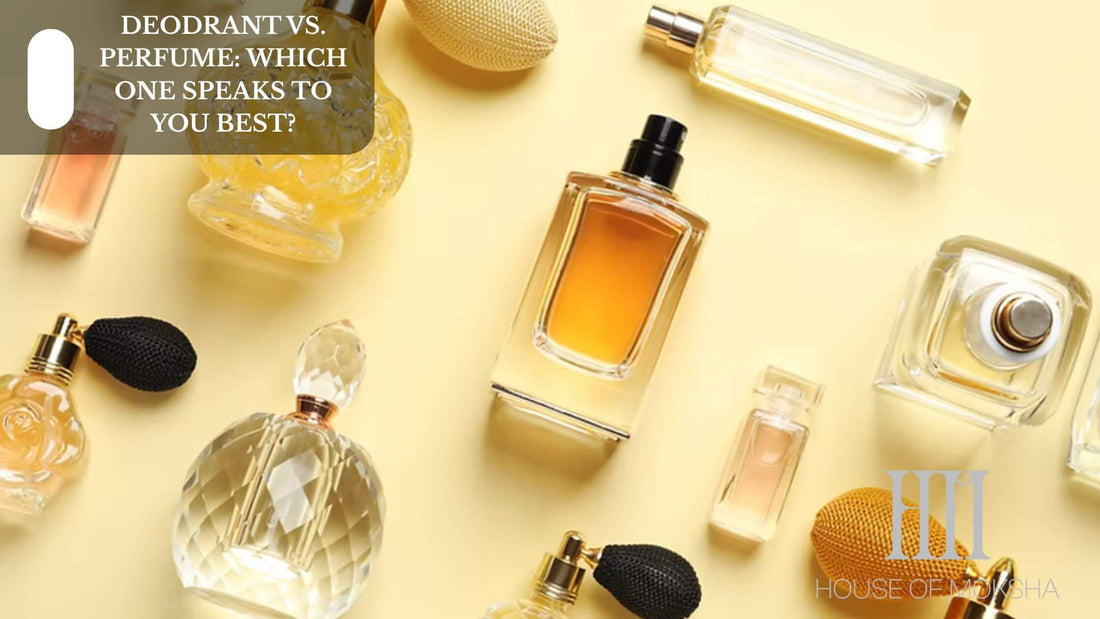
Deodorant vs Perfume: Which One Speaks To You Best?
Share
What Is a Deodorant?
Deodorant is a personal care item primarily created to help people in sweaty areas like underarms prevent bacterial growth from causing body odor. Unlike perfumes, which are designed to cover scent, deodorants neutralize or mask unwanted odors and frequently include antimicrobial agents that lower the bacteria-causing odor.
They aim to keep you fresh and sure all day, particularly during intense exercise or in hot weather. There are several choices of underarm fresheners to fit one's wants and tastes. Sprays, roll-ons, sticks, gels, and creams are among the most commonly used varieties. While some deodorants concentrate entirely on odor control without impacting perspiration, others are combined with antiperspirant characteristics that, by temporarily blocking sweat glands, aid in lowering sweating.
Furthermore, deodorants have a range of scents, from delicate and clean to bold and invigorating, so you can pick one that matches your style or pairs nicely with your favorite fragrance.
What Is a Perfume?
Perfume is an elegant liquid composed of aroma compounds, essential oils, and solvents, giving it a distinct and pleasant scent when placed on a body. Perfume doesn’t aim to mask or eliminate body odor like deodorants do with sweat; rather, it is designed to refine and augment a person's scent. Furthermore, perfume serves a purpose beyond smelling good: it is an expression of personality, an evoker of emotions, and even a trigger of memories through aromatic blends that are intricately crafted. The types of perfumes other than the ones listed below are categorized largely by the amount of aromatic elements they have:
-
Parfum (Extrait de Parfum): The most intense and tough one of them all, possesses 20-30% of fragrance oils. Noticed for its rich scent, which sustains for more than 8 hours, it is perfect for special happenings or evening wear.
-
Eau de Parfum (EDP): A 15-20% concentration of fragrance makes EDPs lighter than parfum yet suitable for everyday wear. Sophisticated and gentile, it gives just the right amount of intensity to last longer throughout the day.
- Eau de Toilette (EDT): Dedicated for the casual closet, it offers a lighter scent that usually lasts 3-4 hours while having 5-15% of fragrance oils. It is suitable for warm areas and gives a nice feeling on a brighter day.
-
Eau De Cologne (EDC): With a lower fragrance concentration of 2-4%, colognes are refreshing and light; however, they tend to dissipate within two hours, making them ideal for a quick lift and go.
Key Differences Between Deodorant and Perfume
-
Purpose and Function: Mostly targeting the body odor produced by bacterial growth in sweat-prone areas such as underarms, deodorants are used. They sometimes have antiperspirant components to lower perspiration and antibacterial agents to eliminate smell. Whereas aromas are naturally produced from plants and other substances, perfumes are designed to give a pleasant and long-lasting smell that can be applied all over the body or on clothes to make a distinctive scent.
-
Composition: Deodorants are usually made of substances, including alcohol, antimicrobial agents, and occasionally aluminum-based materials (in antiperspirants) that fight odor and moisture. Designed to gradually release aroma over time, perfumes are a sophisticated mixture of alcohol or water base, aroma compounds, and essential oils.
- Application Areas: To keep freshness all day, deodorants are mostly used on particular areas likely to sweat, like the underarms. Where the heat from the body helps evaporate the fragrance, perfumes are more flexible and can be squirted on pulse areas, including wrists, neck, and behind the ears.
-
Longevity and Intensity: Deodorants usually have a stronger scent profile and last less than perfumes. From eau de toilette to parfum, the fragrance concentration in perfumes ranges, providing different intensities. Deodorants are generally meant to mask smells rather than offer a long-term perfume using their lighter scent.
How Deodorant Works?
Deodorants are created especially to fight off odor produced by the bacterial decomposition of sweat. Although the wetness of sweat is odorless, bacteria on your skin interact with sweat components to generate offensive odors. By either neutralizing these odor-causing bacteria or covering the scent with fragrances, deodorants help you remain fresh throughout the day.
Though some deodorants also have components meant to minimize sweating, their primary purpose is odor management, not sweat prevention. Related group antiperspirants have active ingredients, including aluminum salts that temporarily block sweat glands, therefore decreasing perspiration.
Knowing this difference is essential in selecting a suitable product for your use. Proper application of deodorant—preferably on clean, dry skin—maximizes its power. Several different types of deodorant—sprays, sticks, gels, or roll-ons—let you decide what fits best your skin and lifestyle.
How Perfume Works?
More than just a nice fragrance, perfume is a precisely mixed mix of aromatic compounds meant to bring out feelings, memories, and personal style. Learning the idea of scent profiles is the first step to understanding how perfume works. Most fragrances have three strata, often called "notes," that evolve on your skin:
-
Top notes: They are the first aromas you detect right following application. Usually light and fresh, top notes are meant to leave a powerful first impression but fade fast, sometimes only 5 to 15 minutes. Among the most popular top notes are mint, citrus, and light flowers.
-
Heart (Middle) Notes: The underlying main source of the scent emerges when the top notes fade. Usually more subdued and rounded, they go on for several hours. Many times, this middle layer is made of floral, fruity, and fiery notes, which give the fragrance depth and character.
- Base Notes: Though they show up last, occasionally hours after application, they persist the longest. Anchoring the scent, base notes give depth and complexity, helping it endure. Vanilla, musk, amber, and woody fragrances are among the usual base notes.
Perfumers produce sophisticated scent profiles by layering these notes thoughtfully, which change throughout the day and interact with your body chemistry to provide a one-of-a-kind fragrance experience. The same fragrance can smell a little different on various people, and at different times; therefore, the selection of perfume becomes a personal statement of identity.
Common Mistakes to Avoid When Using Deodorant and Perfume

First, resist using either item overly. Using deodorant too much can cause irritation of the skin and leave behind stains on clothes; widespread perfume can be offensive and overpowering to others. Layering opposing fragrances—that is, using a potent deodorant and a perfume with another scent profile—can produce a terrible mix.
Choose unscented or mildly scented deodorants while using perfume to keep this from happening. Moreover, a frequent mistake is applying perfume to the wrong spots; the best chances are pulse points like the wrists, neck, and behind the ears, where the warmth aids the fragrance to diffuse naturally. Finally, if necessary, remember to reapply perfume during the day; however, do so sparingly to preserve a subdued and warm scent.
House of Moksha stands as a beacon of purity and elegance in the world of perfumes and deodorants. With a commitment to using high-quality ingredients, sustainable practices, and timeless fragrances, the brand offers more than just scent—it offers an experience. Each product is crafted to evoke serenity, confidence, and individuality, allowing every user to express their essence with grace. As a symbol of conscious luxury, House of Moksha continues to redefine personal care with purpose, passion, and a touch of soulful indulgence.
